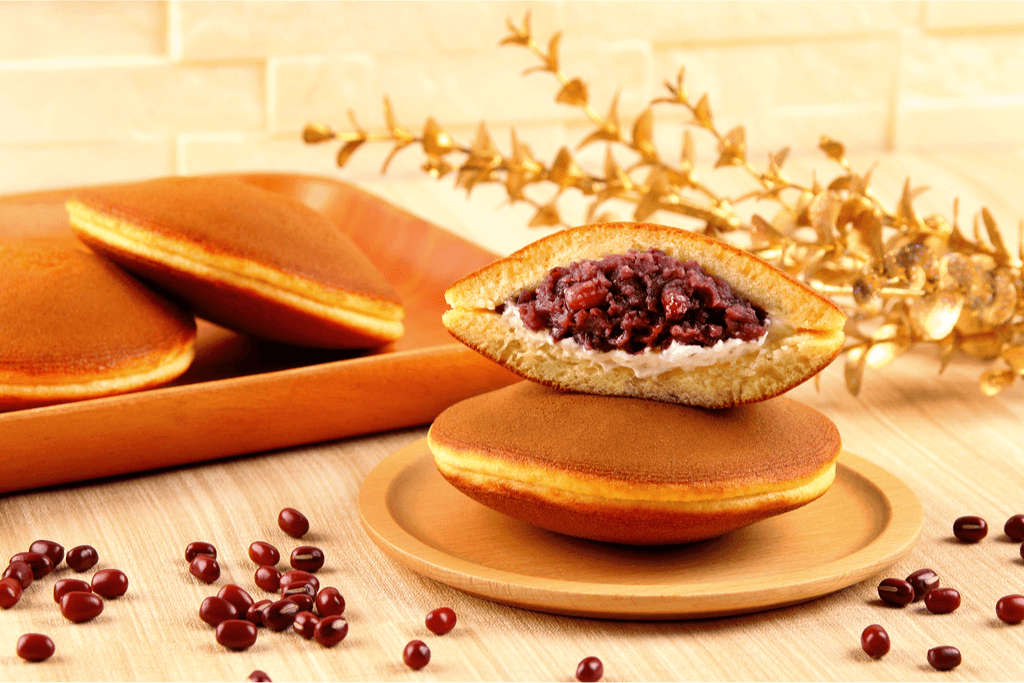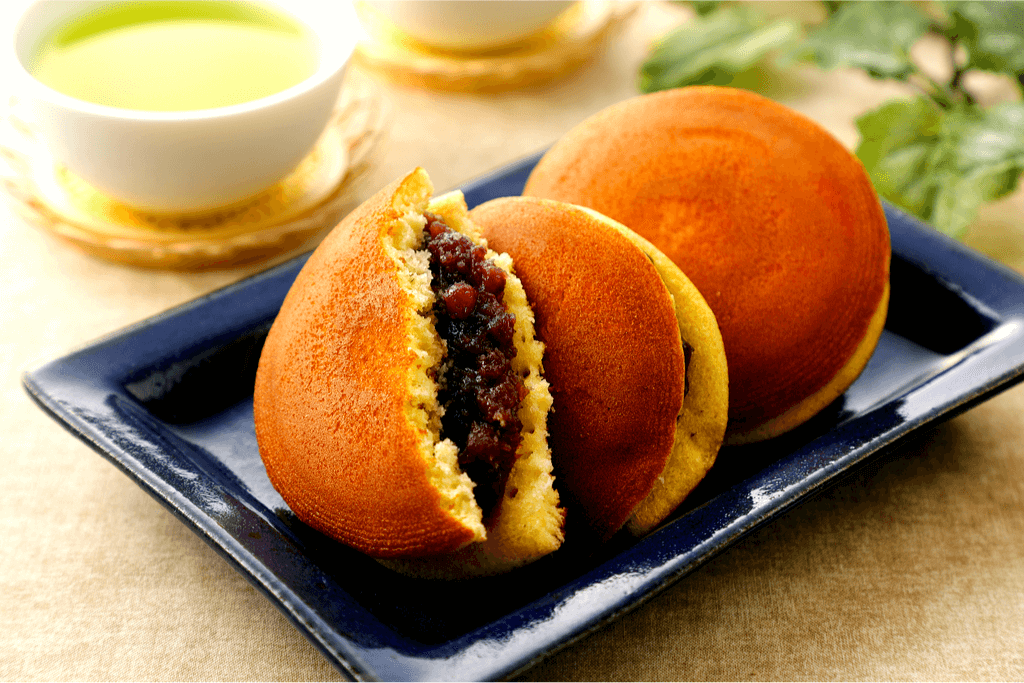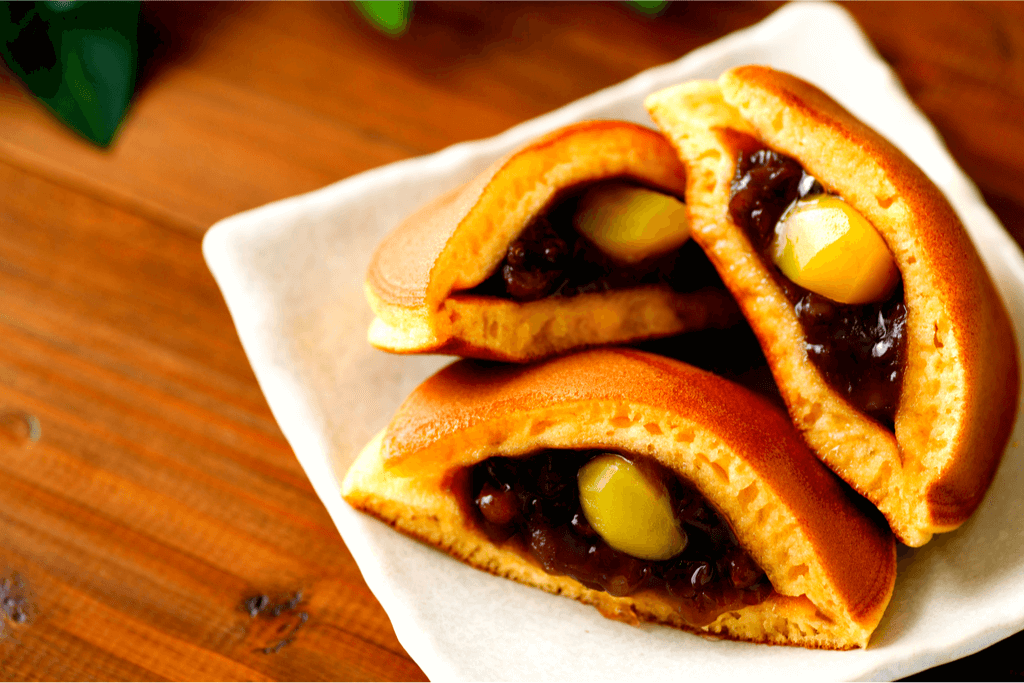dorayaki, food and drink, Japanese sweets
Dorayaki: Japan’s Red Bean Pancake Guide & Recipe
Tanner Schroeder
Posted on March 05, 2021
Share:

Dorayaki: The Japanese Red Bean Pancake
Japanese sweets and confections tend to have an appealing hand-held quality to them. Rather than large cakes and pastries, you often see treats that only take a few bites to devour. Famous miniature snacks such as taiyaki or mochi sweets are typical representations of this. Still, there’s one treat that’s both delicious and adorable: dorayaki!
What is Dorayaki?
Dorayaki is a Japanese confection of two miniature pancake-like patties with sweet azuki bean paste, called anko, nestled inside. The pancakes are closer to the Portuguese castella and are much sweeter and fluffier than their American counterparts. However, that other ingredient, the anko, makes this confection a genuinely traditional Japanese treat.
Anko is made from the azuki bean, a naturally sweet red bean essential to dozens of Japanese sweets. The beans are most commonly boiled, mashed into a smooth paste, and mixed with liberal amounts of sugar. Anko red bean paste is a staple in traditional Japanese snacks such as taiyaki, manju, and parfait. When it comes to the popularity of dorayaki, the anko paste could undoubtedly be considered the star of the show.
What does Dorayaki Taste Like?

Dorayakis are soft, fluffy pancakes with a hint of bean paste on the edges. When you bite into one, your teeth swiftly cut through it. The pancake’s soft texture and sweet bean flavor blend as you chew closer to the center.
As you chew, the earthy sweet bean paste becomes more pronounced. It combines with the pancake for a gratifying and unique flavor. Dorayaki is excellent with milk, Japanese yogurt, coffee, green tea, or a matcha latte.
Looking for delicious Japanese treats like dorayaki? Check out Sakuraco! Sakuraco sends traditional Japanese snacks, teas, sweets, and kitchenware so you can taste Japanese culture in the comfort of your home!
The Dorayaki Recipe

If you buy premade anko paste, you only need to cook the pancakes. Whip eggs, sugar, and honey until smooth, then gently add flour and baking powder until it resembles pancake batter. Preheating and lightly oiling a non-stick frying pan takes roughly five minutes.
To get a golden-brown pancake, wipe off the oil. Put three (3) Tbsp of cooled batter into a low-heat frying pan to make eight (8) cm (3 in) pancakes. After the pancakes, place the anko bean paste in the middle of the dorayaki for the deal tapered look. Then wrap them in plastic!
The History and Culture of Dorayaki

Japanese people enjoyed dorayaki since the first cultural contact between Japan and Portugal in the late 1500s, during the castella trade. Still, in 1914, a little Tokyo candy store called “Usagiya” invented the cakes we consume today.
The word comes from the Japanese words for “gong” (dora) and “grilled” (yaki). This is because the pancake’s bronze and circular shape, which resembles a gong, inspired the name. According to a Heian period folktale, the martial monk Benkei eats a little round cake grilled on a gong, further cementing the snack’s name.
Dorayaki is a significant part of Japanese traditional and popular culture. Every kid learns they’re Doraemon’s favorite snack and energy source. Doraemon stands for doraneko, which means “street cat.” These play-on-words encouraged the writers to add this treat to the story arc.
However, dorayaki comes in all shapes, sizes, and fillings beyond children’s stories. Fancy, gigantic, and all in between. Moreover, some use custard cream, chestnuts, and even matcha cream. Have you ever tried dorayaki before? Let us know in the comments below.

Discover authentic flavors with Sakuraco
Get Sakuraco 
2 Responses

Discover authentic flavors with Sakuraco
Get Sakuraco 
Related Articles

Mochi: How is Mochitsuki Made in Japan?
Mochitsuki is the Japanese tradition of pounding steamed rice to make mochi for the New Year. Families and neighbors gather to participate in this lively and meaningful tradition. The teamwork involved helps everyone feel a sense of connection.

Konpeito Candy: What Makes This Starry Treat Shine?
If you are a fan of the famous Demon Slayer series, then you probably know that the favorite treat of the adorable Nezuko Kamado is those tiny, colorful little sweets.

Kinako: The Amazing Roasted Soybean Powder!
Kinako is a very popular ingredient that can easily be found in many traditional Japanese sweets. It has a distinctive flavor, standing alongside other classic tastes such as red bean or sesame. Let’s explore this charming ingredient together, and who knows, you might even be able to make it in your own beloved kitchen!

Aaron and Claire Make the Ultimate Japanese Pork Belly: Buta no Kakuni
If you want a Japanese dish that’s rich, tender, and simple to follow, Aaron and Claire show exactly how to make it in this episode. Aaron prepares Buta no Kakuni, a classic braised pork belly dish renowned for its rich flavor and tender texture.




I loved this article, thank you Tanner. I don’t know a lot of Japanese language so never knew the meanings behind Doraemon’s name. Looking forward to trying my dorayaki from my box which just arrived today. Also, the taste of red bean paste really grows on you – I say give it a chance even if it sounds unusual to you 😉
Thank you so much, Georgia!
I’m so glad to hear you’re looking forward to enjoying your Sakuraco treats, and I hope that a little background on its origins makes your dorayaki all the sweeter!